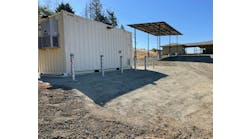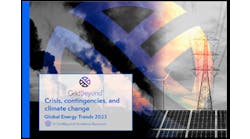Duke Energy has proposed a microgrid to serve the western North Carolina town of Hot Springs as part of a larger plan that includes a $500 million investment in energy storage over 15 years.
Hot Springs, North Carolina photo by upinthehillscasey/Shutterstock
The solar-storage microgrid will bolster electric reliability for the mountainous town served only by a 10-mile, 22.86-kV feeder line, said Zachary Kuznar, Duke Energy’s director, CHP, microgrid and energy storage development.
The utility this week applied to the North Carolina Utilities Commission (NCUC) for the microgrid’s Certificate of Public Convenience and Necessity.
Grid modernization
The Hot Springs microgrid is part of Duke Energy’s Western Carolinas Modernization Project, which includes shutting down a 50-year-old coal-fired power plant in Asheville, North Carolina next year. The microgrid and other distributed energy projects will help Duke defer construction of natural gas-fired generation to replace the coal-fired plant, according to the certificate filing.
The utility did not release the cost of the microgrid but said that the alternative — repairing the 10-mile feeder in the rugged Great Smoky Mountains — would require expensive equipment upgrades. The feeder already incurs “long-duration outage events,” Duke said in the filing.
Lack of right-of-way options also led Duke to pursue the microgrid instead of the more conventional solution of adding a redundant feeder line.
Grid hardening
So-called “grid hardening” — enhancing the resiliency and reliability of the power grid — is Duke’s primary motivation for building the Hot Springs project, Kuznar explained. Operating with 2 MW of solar and 4 MW/4 MWh of lithium-ion batteries, the microgrid will be able to island — disconnect from the main utility grid — during power outages and make use of energy stored in its battery system to meet 90 percent of Hot Springs’ peak load for four to six hours.
“That should give our crews time to get out there and make repairs, ideally before Hot Springs residents even know that an outage occurred,” Kuznar said.
In addition to grid hardening, the microgrid may offer other grid-services, Kuznar said. “It could be used to provide other, bulk-electricity services, such as peak-demand shaving, frequency or voltage regulation.”
The off-grid versus grid-connected microgrid
Mount Sterling Microgrid photo provided by Duke Energy
Duke operates an off-grid, solar-storage microgrid that powers a telecommunications tower on Mount Sterling in the Smoky Mountains National Park. Running for more than a year, the microgrid features a 95-kWh, zinc-air battery energy storage system and 10-kW of solar.
But future microgrids are more likely to be grid-connected — like Hot Springs.
“Opportunities to deploy off-grid microgrids, such as the Mt. Sterling microgrid, are probably fewer and farther between,” Kuznar said. “With grid-tied systems you can capture some of the bulk-system benefits, as well as the local microgrid distribution value, such as grid-hardening.”
300 MW of energy storage planned
The Hot Springs project is part of Duke’s most recent Integrated Resource Plan (IRP), filed in September with the NCUC and currently under review. The plan also calls for installation of 300 MW of battery energy storage on Duke’s system in the Carolinas, where it serves 2.6 million customers.
The 300-MW goal represents a big leap for Duke. The utility has been testing battery energy storage for about 10 years, but has only 15 MW on its system in North Carolina and less in South Carolina.
The Carolinas aren’t the only states where Duke is installing grid-tied, battery energy storage; others include Florida, Indiana, Ohio and Texas. Kuznar pointed out the Indiana Utility Commission recently approved Duke’s proposal for a 7-MW grid-hardening project, similar to Hot Springs, at a substation in Nabb that serves the Indiana National Guard’s Camp Atterbury training operation.
Separately, an unregulated subsidiary of Duke Energy is building energy storage and microgrid projects beyond the service territory of the regulated utility, including in Maryland and Massachusetts.
The bigger picture for Duke Energy
Duke Energy’s energy storage system at the NoTrees wind farm in Texas. Photo provided by Duke Energy
Duke noted in its IRP filing (NCUC Docket No. E-100, Sub 157) that it is developing models to identify the locational value of distributed generation and more tightly link its distribution plans to bulk power requirements.
The resource plan also reduces coal-fired generation from 29 percent of Duke’s portfolio to 18 percent by 2033. Meanwhile, the utility doubles use of renewable resources, energy efficiency and demand-side management from 8 percent in 2019 to 16 percent in 2033. Natural gas grows by 8 percent to become 32 percent of the mix by 2033.
Customer preference motivates Duke’s investment in microgrids, energy storage and other forms of distributed energy, according to the IRP. One of the nation’s largest utilities, Duke serves 7.6 million retail customers in six states.
“We’re looking for these sorts of use cases where storage can be a more cost-effective solution, or in the case of the Hot Springs microgrid the only real solution. We think the costs of these emerging technologies are now at a point where they are a cost-effective tool for transmission and distribution planners considering making upgrades to the system when traditional solutions aren’t feasible,” Kuznar said.
He added: “They’re not always going to be the best solution, but I think in many cases they will be.”
Track news about Duke Energy’s microgrid projects and grid modernization plans. Subsribe to the free Microgrid Knowledge newsletter.







